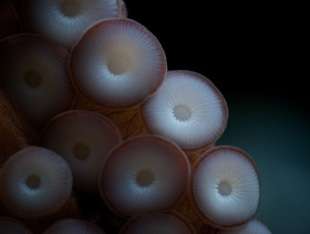The secrets of octopus suckers

(Phys.org) —Research published today in the Royal Society journal Interface investigates how octopus suckers help them attach to surfaces and examines how artificial sucker-like materials compare.
The team, led by Dr Francesca Tramacere have investigated the morphology and the mechanical features of characteristic suckers. They hope that by revealing the properties of these sticking suckers they might inspire a new generation of attachment devices.
The octopus is an 'emblem of soft robotics' say the team from the Instituto Itlaiano di Technologia. With no rigid structure octopus arms can bend in all directions, quickly elongate and change in stiffness.
The morphological properties of these bending and extending limbs has been replicated by experts in bio-mimicry but in recent years octopus suckers have moved into the limelight. Each limb, lined with two rows of suckers ranging from a few centimetres to a few millimetres, can grab wet, non-porous surfaces with minimal energy consumption. Being able to mimic the properties of octopus suckers might allow bio-technology to duplicate these impressive talents.
The team behind this research investigated the morphology and mechanical properties of the two different parts of the suckers: the acetabular which is the cup-like upper part of the sucker, and the infundibular which is the lower part that makes contact with surfaces in an octopus's grip. Using a micro-CT scanner they analysed the surfaces of the suckers. The acetabular was fairly smooth whilst the infundibular was covered in grooves which spread low pressureproduced by the acetabular over the whole infundibular surface. This aids suction and helps octopuses hold tight to surfaces even when they are wet.
The team also measured the mechanical properties of octopus suckers. They found the tissues that the suckers are made of are some of the softest biological materials, as soft as jellyfish jelly. The team suggest the softness of the tissues, especially the infundibular, mean the suckers can closely align with the surfaces they grip, molding to their shape to make a water-tight seal.
The researchers compared their results to current materials used to mimic octopus suckers. They found artificial suckers were made from smooth materials which did not replicate the grooved textured surface of the infundibular. The researchers concluded that to truly recreate the properties of octopus suckers two types of material are needed- one soft and vicious to mimic the infundibular and a more elastic and slightly stiffer material to replicate the hollow acetabular.
More information: Structure and mechanical properties of Octopus vulgaris suckers, dx.doi.org/10.1098/rsif.2013.0816
Journal information: Journal of the Royal Society Interface
Provided by The Royal Society


















